Author: filippopozzi, web3 researcher Source: medium Translation: Shan Ouba, Jinse Finance
The Bitcoin spot ETF was approved in early January 2024, providing important new investment opportunities for individuals and institutional firms that need regulated tools to enter the cryptocurrency market. Having overcome the excitement of the first few months, we now have the opportunity to analyze the impact of these ETFs on the market with more calm and complete information. As is our custom in this channel, let us do this by examining the most relevant data.
Market Price
Let’s start with the most common analysis, price analysis. The approval of the Bitcoin ETF on January 11, 2024, sparked a huge interest in the space, which translated into a massive price increase, from around $45,000 on the day of approval to an all-time high of around $73,000, before stabilizing at around $65,000.
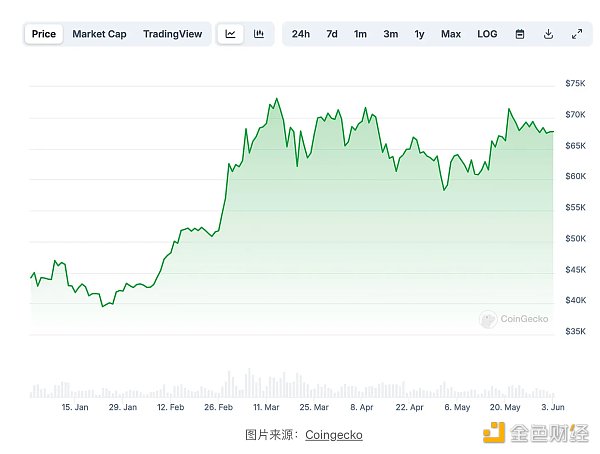
Trading volume
Another important metric for evaluating the success of an ETF (especially for the issuer) is of course trading volume, because for the issuer the rule of "volume = commission" applies.
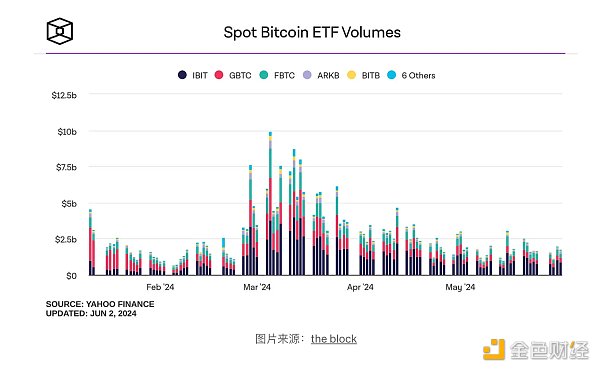
From this data sheet we can see that overall trading volume achieved excellent results in the first few days after launch, but trading volume slowed down slightly before exploding in March, with the total daily trading volume of all ETFs peaking at nearly $10 billion. By analyzing the colors of the different candles, we notice that BlackRock's ETF IBIT (represented by dark blue) is the most traded ETF. It is followed by Grayscale ETF GBTC, although in this case the trading volume is mostly negative because it used to be a trust fund and recently converted to a spot ETF with very low commissions compared to its competitors. In third place is Fidelity's ETF FBTC.
Value of assets under management
Now let's focus on analyzing the size of funds in the market. Before that, let's explain a little about the ETF GBTC, which is represented in red in the figure below. It can be clearly seen that GBTC is the only ETF that manages a large amount of Bitcoin on the day of its launch. But how is this possible if all ETFs are launched on the same day?
GBTC, or Grayscale Bitcoin Trust, is a trust before it becomes a spot ETF, as it has not received approval from the U.S. Securities and Exchange Commission (SEC) for a spot Bitcoin ETF. The trust is one of the first financial instruments designed to provide Bitcoin investment opportunities, and compared to spot ETFs, it features a closed-end fund with less stringent regulation, so it can be brought to market before the SEC approves a spot ETF.
Since GBTC has now converted to a spot ETF like all other ETFs, but with much higher fees than its competitors, the GBTC fund is slowly losing more and more BTC to other ETFs.
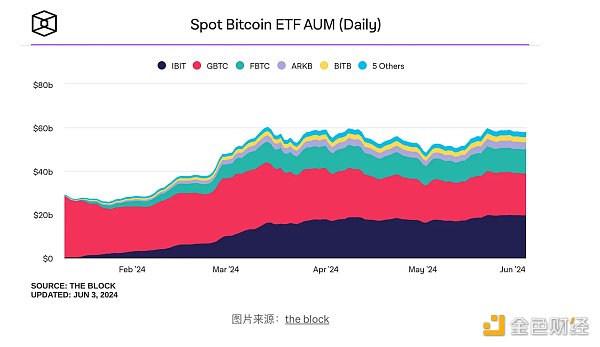
After highlighting the case of GBTC, it can be seen from this chart that the two ETFs with the fastest growth are IBIT and FBTC, the BlackRock and Fidelity ETFs, which confirms the previous analysis of trading volume. They are followed by ARKB (ARK Invest ETF) and BITB (Bitwise ETF), although their market capitalizations are much smaller.
A final point to consider about this chart is that after peaking between March and April, the value of assets under management in funds has ceased to grow, stabilizing at around $60 billion, leading to a slowdown in the price of Bitcoin, as highlighted in previous analysis.
Comparison of the Shares Bitcoin Trust and the iShares Gold Trust
To get a fuller picture of the size of these new ETFs, and to avoid numbers becoming meaningless, I suggest comparing BlackRock’s Bitcoin ETF (IBIT) to BlackRock’s Gold ETF (IAU).
It is important to emphasize that this comparison cannot be considered free of asymmetry, given the different nature of the two topics examined and the different roles that gold and Bitcoin may play in institutional portfolios.
Therefore, we will limit ourselves to seeking general information, placing this new Bitcoin ETF in the “traditional” market landscape, and gaining a broader understanding of how the institutional world views Bitcoin.
For the purposes of this analysis, I have only provided the data reported by BlackRock on the respective ETF pages, and I have left links to the pages for the iShares Bitcoin Trust and the iShares Gold Trust .
Key Factors iShares Bitcoin Trust
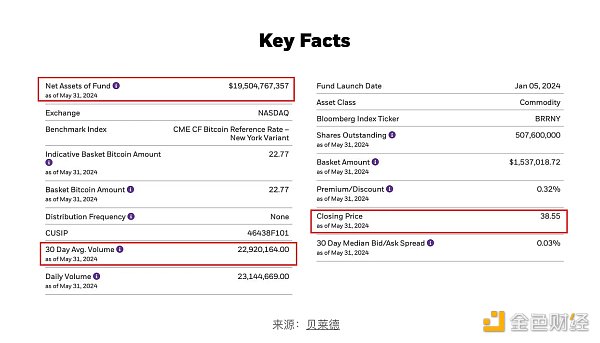
Key Factors iShares Gold Trust
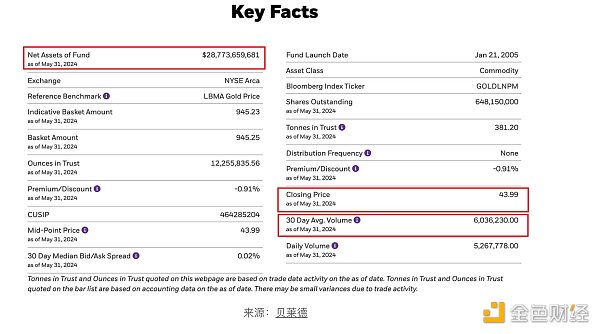
Let’s take a closer look at these numbers. As you can see, I’ve highlighted the data that I believe is most relevant for our purposes, namely the value of assets under management, the average number of shares traded during a trading day, and the closing price of the ETF (we need to calculate volume in USD).
Value of assets under management of the fund → As highlighted in the provided image, the Bitcoin ETF is valued at around $19 billion, while the Gold ETF is valued at around $28 billion, showing a surprising closeness between the two ETFs.
Volume → Considering that the number reported under "30-day average volume" represents the average number of shares traded within the ETF, we can multiply that number by the share price to get the volume in USD. In our case, we use the closing price as a reference. Therefore, the average daily volume of the Bitcoin ETF last month was about $800 million, while the average daily volume of the Gold ETF was about $260 million, indicating that BlackRock's clients were more interested in the Bitcoin ETF than the Gold ETF last month. The following focuses on the daily volume history of the BlackRock Bitcoin ETF.

If you were surprised by these data, so was I! After analyzing the gold ETFs of one of the world’s most important fund managers, before conducting this analysis, I expected that the value of assets under management and trading volume would be orders of magnitude different in favor of the gold ETFs. However, once the values reported by the two ETFs were analyzed, this expectation was completely shattered, revealing that the institutional market has a higher than expected interest in this new asset.
I would like to (re)clarify that these data are not a perfect reflection of the market situation, as we are still in the phase where institutional investors are first exposed to this asset, and reiterate that gold plays a completely different role than Bitcoin on a global scale, at least for now, as reported in the global capitalization asset rankings.
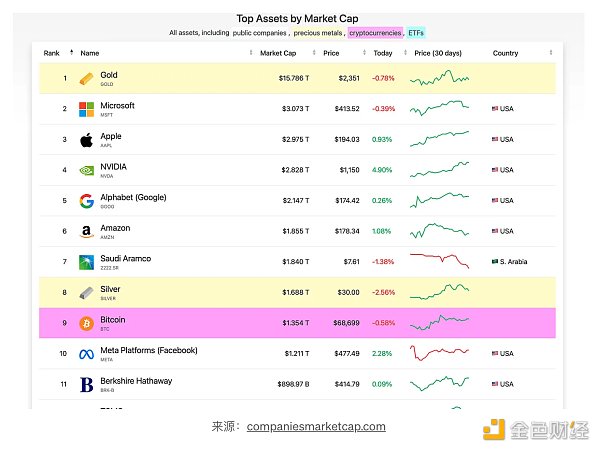 Nevertheless, it is undeniable that this ETF, especially the one managed by BlackRock, has achieved considerable commercial success, confirming that Bitcoin has entered the world of bigwigs and has been institutionalized in this world.
Nevertheless, it is undeniable that this ETF, especially the one managed by BlackRock, has achieved considerable commercial success, confirming that Bitcoin has entered the world of bigwigs and has been institutionalized in this world.





